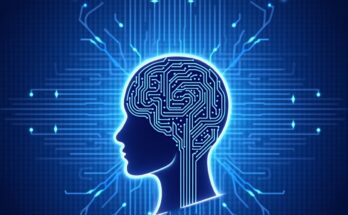Introduction
Keeping track of the tech industry has always come with its own set of challenges, given that there have always been new innovations at play. Now, as we move to 2025, it is evident that technology is advancing at an accelerated pace. Yes, we are talking about innovations that have the potential to revolutionize our work structures, communication methods, as well as the way we conduct daily tasks. Amid all of this, it is important to identify which trends truly matter. But don’t worry! I’ve got your back.
In this article, we’re going to explore the top 10 tech trends to follow in 2025. These trends are not some far-fetched prophecies, but rather they are already emerging and setting up for the future.
1: Artificial Intelligence is Everywhere
AI is estimated to gain further recognition and rave in 2025, despite existing for a while. If you thought voice operating assistants like Siri and Alexa were the limits of AI technology, you will be stunned. AI is slowly integrating into almost every tool and product we use, smart or otherwise, and whether it is acknowledged or not.
In 2025, we will have features such as AI that provide assistance and simplify our daily activities. Picture leisurely sending emails, accomplishing tasks, and content creation. Not only the needles and buttons will be done automatically but also AI will have the ability to properly understand your needs and request before you require help. With Edge AI enabled devices and applications, which analyze data on the device, results are instantaneous and don’t require the user to send data to the cloud. These devices and applications will provide instant results and be more secure.
In this advancing age, these sophisticated tools are not mere machines. They will function as advanced colleagues, personal assistants, and aides, that learn, adapt, and grow with the user’s developed patterns. However, it’s going to be much more than that.
We are yet to witness changes like these, but once they arrive, it’s believed that the leap in quantum computing will take place around the same time. Just like AI, some tech enthusiasts consider quantum computing to be science-fiction, admiring the development from distance. But instead, practitioners will begin experimenting with active applications of the technology.
But don’t toss out your laptop or smartphone on the leap day, because there are still practical use cases quantum computers will have to adjust to.
These machines incorporate quantum computing with quantum chemically focused models, which utilize quantum bits (qubits) that execute intricate calculations at a previously unimaginable pace. What does this allow for you? To begin with, breakthroughs in drug development alongside improved healthcare services, climate modeling, and cybersecurity could be on the horizon. Additionally, several providers have already begun offering quantum-as-a-service, enabling businesses and researchers to access the technology directly.
Quantum computing remains in its developmental stages, with its trajectory extremely promising.
3. The Rise of 6G and Expanded 5G Networks
We’ve established that 5G is already in use, and at least in some regions, it is a technological advancement. With 5G, users experience fast internet, low latency, and secured connections which are transforming gaming alongside remote work. However, 2025 is the key year when the full potential of 5G will be unlocked, and even more fascinating, 6G is already being discussed.
5G technology is expected to reach full coverage by 2025. Autonomous vehicles and smart cities are just a few examples of what will come. The Internet, on the other hand, will have enhanced speed, reliability, and responsiveness. However, 6G technology is expected to take things a step further—picture the ability to download an entire movie in a fraction of a second. While still in the research phase, 6G technology promises to take immersive experiences to a whole new level, beyond what we currently consider advanced.
4. Extended Reality (XR) Will Change How We Live and Work
With 2025 around the corner, XR (Extended Reality) technology will unify virtual reality (VR) and augmented reality (AR) into a single package, changing how we complete tasks. You’ll be able to attend work meetings set in an office with colleagues from different countries. You’ll also be able to shop for clothes in virtual reality stores and try things on without having to leave your house.
In 2025, enhanced reality (AR) will aid you in viewing relevant data superimposed on the real world. XR headsets like Apple Vision Pro will provide novel immersive experiences for learning, entertainment, and even remote healthcare. And guess what? It’s no longer just about fun or leisure activities.
5. Sustainability and Green Tech Assume Dominance
If you have been attentive, you know that sustainability has shifted from being a mere trend. It is now an important consideration for the technology industry, and is making serious moves towards eco-friendly options. In 2025, companies will focus on emission control, waste mitigation, and utilizing energy-efficient resources within their products.
Expect innovative eco-friendly products such as smartphones that can be repaired or come with a recycling identification design, alongside renewable powered green data centers. Even the cloud is working towards improving its environmental performance, adopting technologies to reduce their ecological footprint. In simple terms, the tech sector will be more responsible for its actions.
Why is it important?
As we already mentioned, the consumers. There is an increasing demand for eco-friendly products, and companies are becoming aware that they cannot ignore it.
6. Smarter and More Customized Cybersecurity
The more we connect, the harder cyber threats become. Whichever the case, new threats are being introduced every second. However, protective measure are introduced at the same speed, meaning the evolving problem can also be countered. By the year 2025, we shall see AI-powered security tools which will automatically protect data as breaches occur.
Tackling the problem from a different angle, personally identifying securities will be stronger thanks to the blockchain. Expanding these strategies to remove trust boundaries, zero devise trust security measures block off all access until verification is passed, making remote identity confirmation protection near impossible to bypass.
7. More Interconnected Smart Devices
Walking past modern day homes, you can point out smart devices such fridges and ovens. Progressing into the later years, the time linking will become more advanced, meaning a precise schedule can be configured. Smart devices will be able to memorize your preferences and sync to the time table effortlessWays
From health wearables to smart cities controlling waste and enhanced traffic supervision. With these devices, homes and businesses will expect enhanced productivity, lower energy waste and perform more tasks during less span os time easily without the need to constantly monitor them.
8. Robots Are Moving Beyond the Factory Floor
The innovation of robots is not only prevalent in the manufacturing setting. Innovations like healthcare, logistics, customer service and even home cleaning are beginning to use robots to enhance their service.
Soon, robots will be aiding in surgeries, delivering packages and performing customer query tasks. These machines are not substitutions; they are helpers for repetitive and dangerous tasks, so humans are able to concentrate on the meaningful tasks.
9. Web3 Will Evolve Beyond Crypto
The decentralized version of the internet, Web3, is still in its infant stages but is evolving in interesting ways. We mean not just cryptocurrency or NFTs ( non-fungible tokens). The aspect of Web3 focuses on user interaction and gives full control over their data without depending on centralized systems.
Decentralized applications (dApps) are bound to be user friendly by 2025, alongside the promise of blockchain for increased security and transparency in processes like financial transactions, digital art and even voting.
10: AI and Humans Will Collaborate in New Creative Ways
Here’s an interesting twist: by 2025, I see human and AI collaboration resulting in the next major breakthroughs. AI will be a partner instead of a tool in creative tasks, including scriptwriting, music generation, and artwork creation.
AI will assist in human workflows by offering novel suggestions, offering them new avenues to explore, all the while improving the pace of work done. This means that instead of taking human creators out of the picture, AI would continue to lend a hand in the collaborative process. The age in which we live in is one where the creativity and imagination of humans is augmented and amplified by the power of technology.
Conclusion:
The Coming Years Will Be Fast-Paced and Full of Opportunity
The upcoming trends in technology for the year of 2025 are not only beautiful but also paradigm shifting. In that the horizons hold a reality where AI is not merely a serving caravan of tools, but is a core constituent in everything that is done. It is a time where robots do not supplant us, but actually lend us a helping hand. Further, a time where the power of the internet is not controlled by a select few, but is instead available to users everywhere in a more decentralized fashion.
Do not fall behind these trends, and make a change to stay informed, as doing so will allow you to remain several steps ahead as technological advancement continues to unfold in the world.
FAQs
Q: What do I have to do in order to align myself with the upcoming tech trends?
A: Try to stay updated with the latest technologies, and put your hands on new tools, even start using them. Many of these innovations can be easily accessed right now in one form or the other.
Q: Are my professional prospects bound to change because of these trends?
A: That depends on the nature of your work, but for a majority of the population, especially in the areas of AI, cybersecurity, and digital innovation, this would mean new doors and avenues waiting to be explored.



